Research Project: Talent Management Strategies at Lloyds Bank PLC
VerifiedAdded on 2022/12/23
|33
|8819
|1
Report
AI Summary
This project report examines talent management strategies at Lloyds Bank, focusing on employee retention and organizational practices. The report begins with an introduction to Lloyds Bank, its organizational structure, and the background of the research topic. It outlines the aims, objectives, and research questions, followed by a rationale for the research and its significance. The report then details the project management planning, including cost analysis, scope, quality assurance, and risk assessment. A literature review explores current talent management strategies used by banks, the importance of talent management, and the effects of ineffective talent management. The research methodology includes a work breakdown structure, Gantt chart, and questionnaire survey. The findings and data interpretation are presented in the data analysis and discussion chapter. The report concludes with personal reflections, conclusions, limitations, and recommendations for improving talent management practices at Lloyds Bank. The study aims to provide insights into how the bank can improve employee retention and overall organizational effectiveness.

Managing a
Successful Business
Project
Successful Business
Project
Paraphrase This Document
Need a fresh take? Get an instant paraphrase of this document with our AI Paraphraser
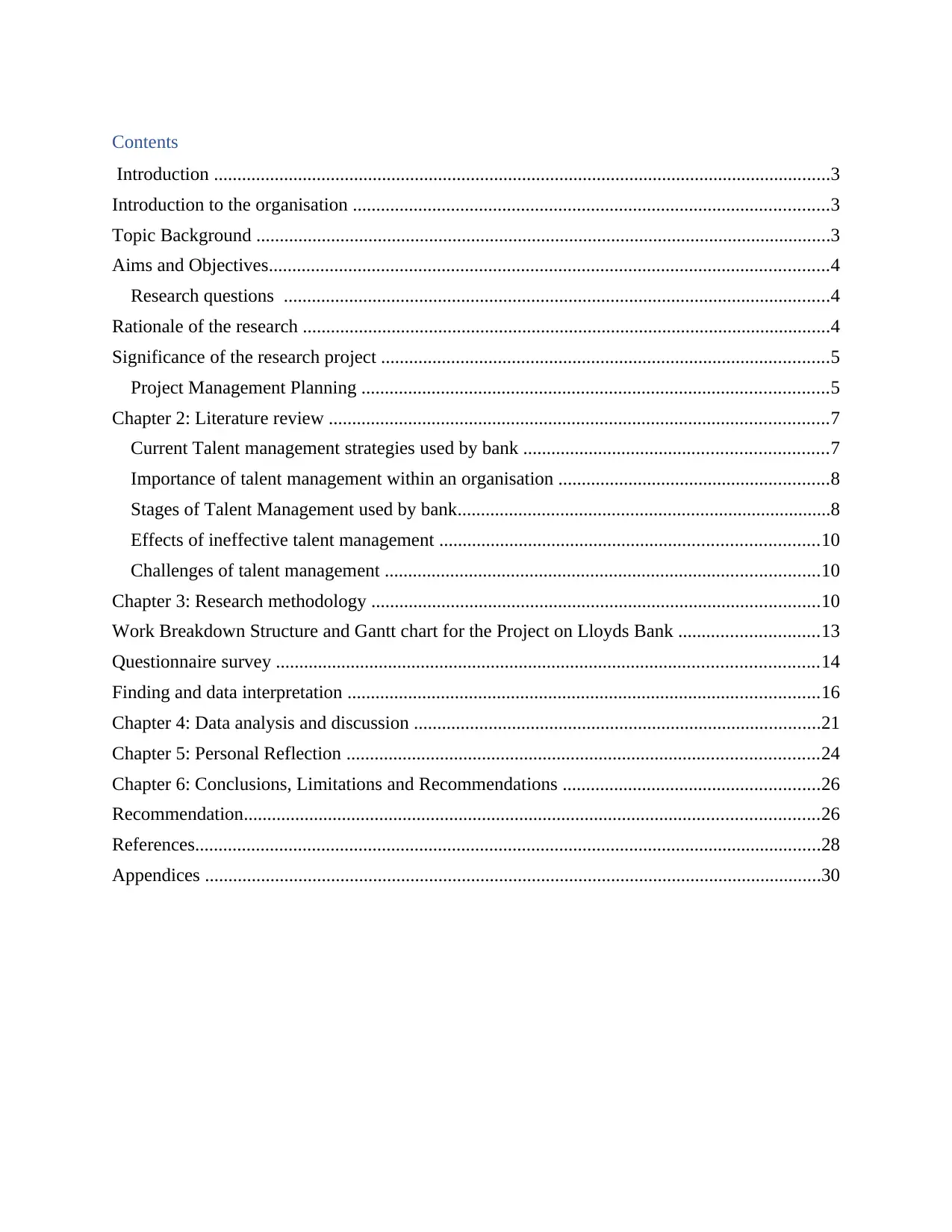
Contents
Introduction ....................................................................................................................................3
Introduction to the organisation ......................................................................................................3
Topic Background ...........................................................................................................................3
Aims and Objectives........................................................................................................................4
Research questions .....................................................................................................................4
Rationale of the research .................................................................................................................4
Significance of the research project ................................................................................................5
Project Management Planning ....................................................................................................5
Chapter 2: Literature review ...........................................................................................................7
Current Talent management strategies used by bank .................................................................7
Importance of talent management within an organisation ..........................................................8
Stages of Talent Management used by bank................................................................................8
Effects of ineffective talent management .................................................................................10
Challenges of talent management .............................................................................................10
Chapter 3: Research methodology ................................................................................................10
Work Breakdown Structure and Gantt chart for the Project on Lloyds Bank ..............................13
Questionnaire survey ....................................................................................................................14
Finding and data interpretation .....................................................................................................16
Chapter 4: Data analysis and discussion .......................................................................................21
Chapter 5: Personal Reflection .....................................................................................................24
Chapter 6: Conclusions, Limitations and Recommendations .......................................................26
Recommendation...........................................................................................................................26
References......................................................................................................................................28
Appendices ....................................................................................................................................30
Introduction ....................................................................................................................................3
Introduction to the organisation ......................................................................................................3
Topic Background ...........................................................................................................................3
Aims and Objectives........................................................................................................................4
Research questions .....................................................................................................................4
Rationale of the research .................................................................................................................4
Significance of the research project ................................................................................................5
Project Management Planning ....................................................................................................5
Chapter 2: Literature review ...........................................................................................................7
Current Talent management strategies used by bank .................................................................7
Importance of talent management within an organisation ..........................................................8
Stages of Talent Management used by bank................................................................................8
Effects of ineffective talent management .................................................................................10
Challenges of talent management .............................................................................................10
Chapter 3: Research methodology ................................................................................................10
Work Breakdown Structure and Gantt chart for the Project on Lloyds Bank ..............................13
Questionnaire survey ....................................................................................................................14
Finding and data interpretation .....................................................................................................16
Chapter 4: Data analysis and discussion .......................................................................................21
Chapter 5: Personal Reflection .....................................................................................................24
Chapter 6: Conclusions, Limitations and Recommendations .......................................................26
Recommendation...........................................................................................................................26
References......................................................................................................................................28
Appendices ....................................................................................................................................30
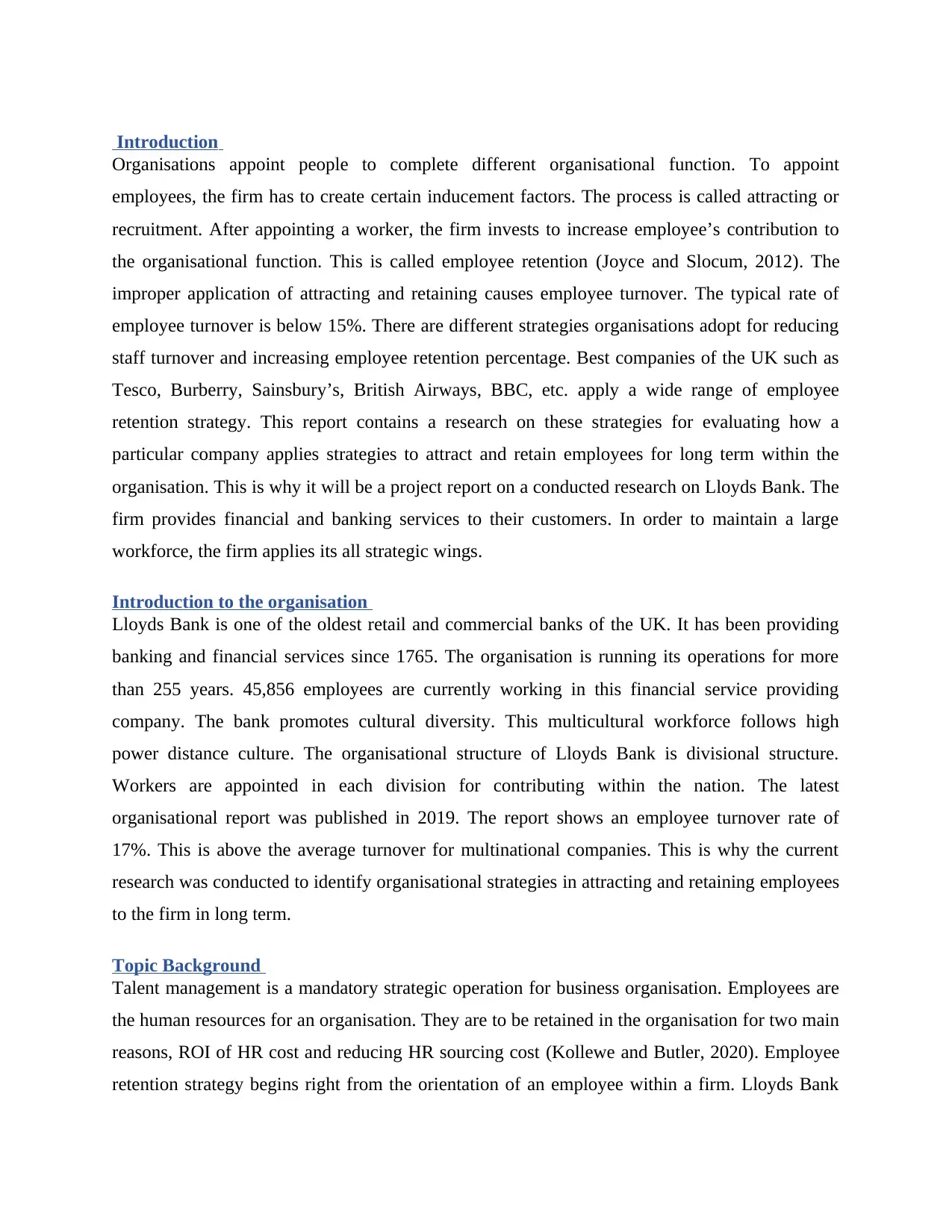
Introduction
Organisations appoint people to complete different organisational function. To appoint
employees, the firm has to create certain inducement factors. The process is called attracting or
recruitment. After appointing a worker, the firm invests to increase employee’s contribution to
the organisational function. This is called employee retention (Joyce and Slocum, 2012). The
improper application of attracting and retaining causes employee turnover. The typical rate of
employee turnover is below 15%. There are different strategies organisations adopt for reducing
staff turnover and increasing employee retention percentage. Best companies of the UK such as
Tesco, Burberry, Sainsbury’s, British Airways, BBC, etc. apply a wide range of employee
retention strategy. This report contains a research on these strategies for evaluating how a
particular company applies strategies to attract and retain employees for long term within the
organisation. This is why it will be a project report on a conducted research on Lloyds Bank. The
firm provides financial and banking services to their customers. In order to maintain a large
workforce, the firm applies its all strategic wings.
Introduction to the organisation
Lloyds Bank is one of the oldest retail and commercial banks of the UK. It has been providing
banking and financial services since 1765. The organisation is running its operations for more
than 255 years. 45,856 employees are currently working in this financial service providing
company. The bank promotes cultural diversity. This multicultural workforce follows high
power distance culture. The organisational structure of Lloyds Bank is divisional structure.
Workers are appointed in each division for contributing within the nation. The latest
organisational report was published in 2019. The report shows an employee turnover rate of
17%. This is above the average turnover for multinational companies. This is why the current
research was conducted to identify organisational strategies in attracting and retaining employees
to the firm in long term.
Topic Background
Talent management is a mandatory strategic operation for business organisation. Employees are
the human resources for an organisation. They are to be retained in the organisation for two main
reasons, ROI of HR cost and reducing HR sourcing cost (Kollewe and Butler, 2020). Employee
retention strategy begins right from the orientation of an employee within a firm. Lloyds Bank
Organisations appoint people to complete different organisational function. To appoint
employees, the firm has to create certain inducement factors. The process is called attracting or
recruitment. After appointing a worker, the firm invests to increase employee’s contribution to
the organisational function. This is called employee retention (Joyce and Slocum, 2012). The
improper application of attracting and retaining causes employee turnover. The typical rate of
employee turnover is below 15%. There are different strategies organisations adopt for reducing
staff turnover and increasing employee retention percentage. Best companies of the UK such as
Tesco, Burberry, Sainsbury’s, British Airways, BBC, etc. apply a wide range of employee
retention strategy. This report contains a research on these strategies for evaluating how a
particular company applies strategies to attract and retain employees for long term within the
organisation. This is why it will be a project report on a conducted research on Lloyds Bank. The
firm provides financial and banking services to their customers. In order to maintain a large
workforce, the firm applies its all strategic wings.
Introduction to the organisation
Lloyds Bank is one of the oldest retail and commercial banks of the UK. It has been providing
banking and financial services since 1765. The organisation is running its operations for more
than 255 years. 45,856 employees are currently working in this financial service providing
company. The bank promotes cultural diversity. This multicultural workforce follows high
power distance culture. The organisational structure of Lloyds Bank is divisional structure.
Workers are appointed in each division for contributing within the nation. The latest
organisational report was published in 2019. The report shows an employee turnover rate of
17%. This is above the average turnover for multinational companies. This is why the current
research was conducted to identify organisational strategies in attracting and retaining employees
to the firm in long term.
Topic Background
Talent management is a mandatory strategic operation for business organisation. Employees are
the human resources for an organisation. They are to be retained in the organisation for two main
reasons, ROI of HR cost and reducing HR sourcing cost (Kollewe and Butler, 2020). Employee
retention strategy begins right from the orientation of an employee within a firm. Lloyds Bank
⊘ This is a preview!⊘
Do you want full access?
Subscribe today to unlock all pages.

Trusted by 1+ million students worldwide
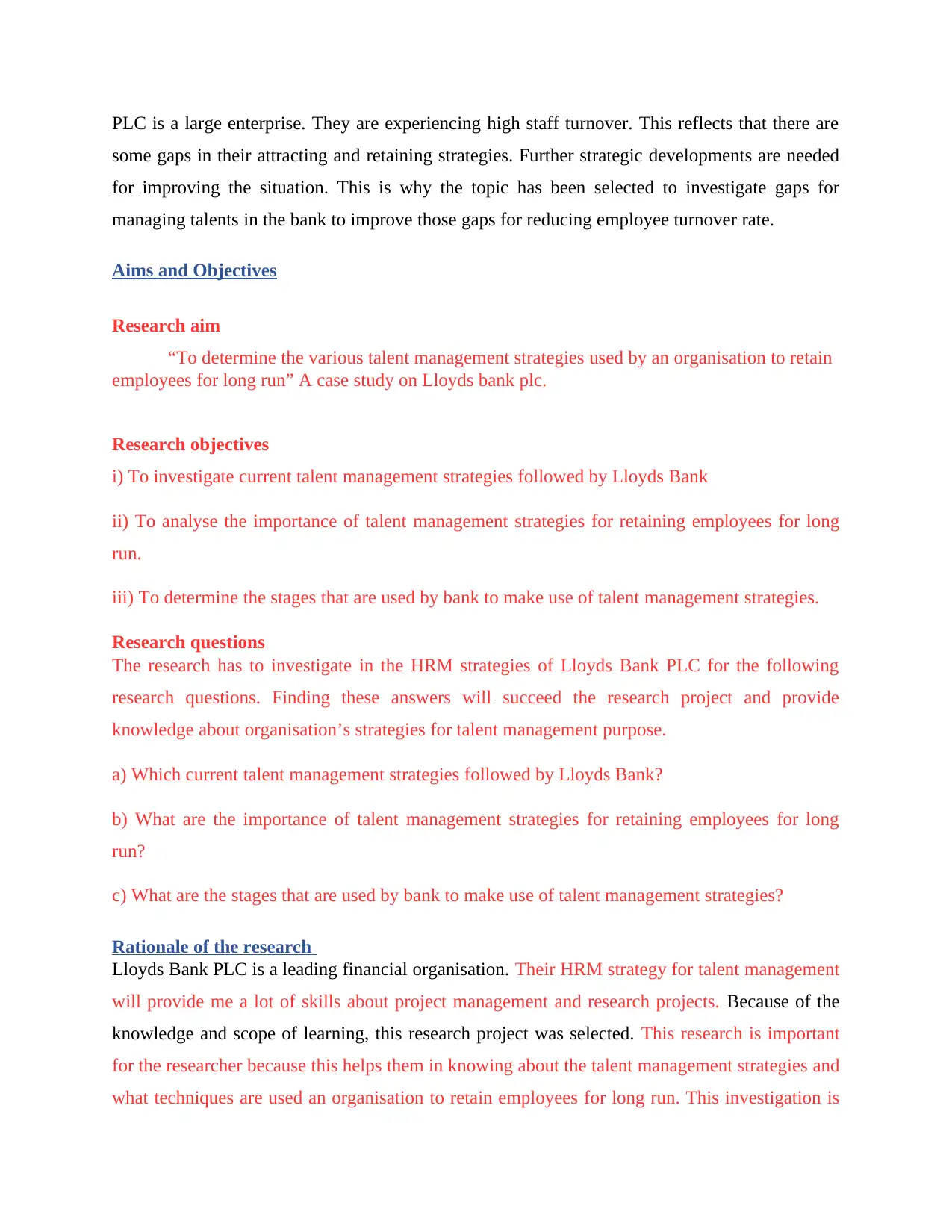
PLC is a large enterprise. They are experiencing high staff turnover. This reflects that there are
some gaps in their attracting and retaining strategies. Further strategic developments are needed
for improving the situation. This is why the topic has been selected to investigate gaps for
managing talents in the bank to improve those gaps for reducing employee turnover rate.
Aims and Objectives
Research aim
“To determine the various talent management strategies used by an organisation to retain
employees for long run” A case study on Lloyds bank plc.
Research objectives
i) To investigate current talent management strategies followed by Lloyds Bank
ii) To analyse the importance of talent management strategies for retaining employees for long
run.
iii) To determine the stages that are used by bank to make use of talent management strategies.
Research questions
The research has to investigate in the HRM strategies of Lloyds Bank PLC for the following
research questions. Finding these answers will succeed the research project and provide
knowledge about organisation’s strategies for talent management purpose.
a) Which current talent management strategies followed by Lloyds Bank?
b) What are the importance of talent management strategies for retaining employees for long
run?
c) What are the stages that are used by bank to make use of talent management strategies?
Rationale of the research
Lloyds Bank PLC is a leading financial organisation. Their HRM strategy for talent management
will provide me a lot of skills about project management and research projects. Because of the
knowledge and scope of learning, this research project was selected. This research is important
for the researcher because this helps them in knowing about the talent management strategies and
what techniques are used an organisation to retain employees for long run. This investigation is
some gaps in their attracting and retaining strategies. Further strategic developments are needed
for improving the situation. This is why the topic has been selected to investigate gaps for
managing talents in the bank to improve those gaps for reducing employee turnover rate.
Aims and Objectives
Research aim
“To determine the various talent management strategies used by an organisation to retain
employees for long run” A case study on Lloyds bank plc.
Research objectives
i) To investigate current talent management strategies followed by Lloyds Bank
ii) To analyse the importance of talent management strategies for retaining employees for long
run.
iii) To determine the stages that are used by bank to make use of talent management strategies.
Research questions
The research has to investigate in the HRM strategies of Lloyds Bank PLC for the following
research questions. Finding these answers will succeed the research project and provide
knowledge about organisation’s strategies for talent management purpose.
a) Which current talent management strategies followed by Lloyds Bank?
b) What are the importance of talent management strategies for retaining employees for long
run?
c) What are the stages that are used by bank to make use of talent management strategies?
Rationale of the research
Lloyds Bank PLC is a leading financial organisation. Their HRM strategy for talent management
will provide me a lot of skills about project management and research projects. Because of the
knowledge and scope of learning, this research project was selected. This research is important
for the researcher because this helps them in knowing about the talent management strategies and
what techniques are used an organisation to retain employees for long run. This investigation is
Paraphrase This Document
Need a fresh take? Get an instant paraphrase of this document with our AI Paraphraser
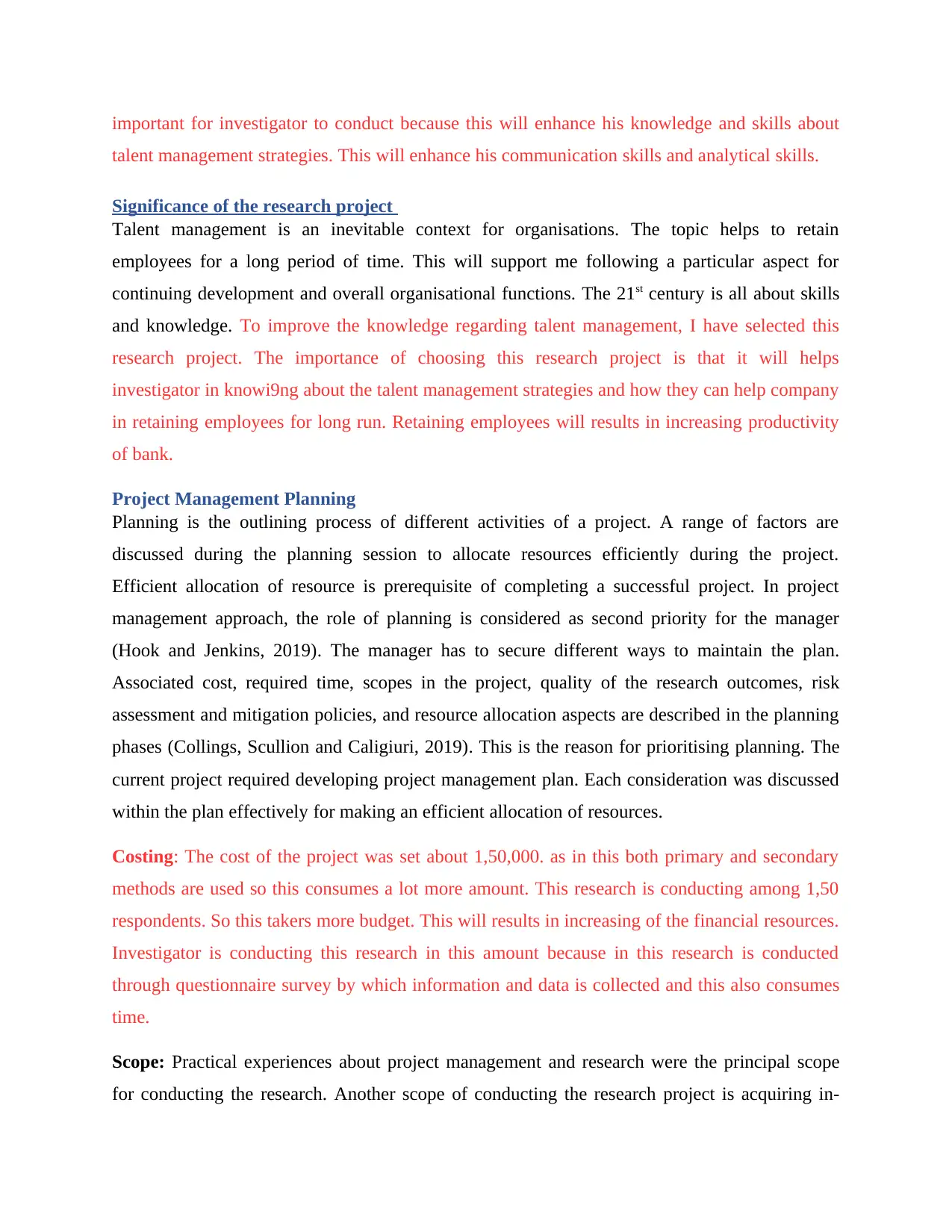
important for investigator to conduct because this will enhance his knowledge and skills about
talent management strategies. This will enhance his communication skills and analytical skills.
Significance of the research project
Talent management is an inevitable context for organisations. The topic helps to retain
employees for a long period of time. This will support me following a particular aspect for
continuing development and overall organisational functions. The 21st century is all about skills
and knowledge. To improve the knowledge regarding talent management, I have selected this
research project. The importance of choosing this research project is that it will helps
investigator in knowi9ng about the talent management strategies and how they can help company
in retaining employees for long run. Retaining employees will results in increasing productivity
of bank.
Project Management Planning
Planning is the outlining process of different activities of a project. A range of factors are
discussed during the planning session to allocate resources efficiently during the project.
Efficient allocation of resource is prerequisite of completing a successful project. In project
management approach, the role of planning is considered as second priority for the manager
(Hook and Jenkins, 2019). The manager has to secure different ways to maintain the plan.
Associated cost, required time, scopes in the project, quality of the research outcomes, risk
assessment and mitigation policies, and resource allocation aspects are described in the planning
phases (Collings, Scullion and Caligiuri, 2019). This is the reason for prioritising planning. The
current project required developing project management plan. Each consideration was discussed
within the plan effectively for making an efficient allocation of resources.
Costing: The cost of the project was set about 1,50,000. as in this both primary and secondary
methods are used so this consumes a lot more amount. This research is conducting among 1,50
respondents. So this takers more budget. This will results in increasing of the financial resources.
Investigator is conducting this research in this amount because in this research is conducted
through questionnaire survey by which information and data is collected and this also consumes
time.
Scope: Practical experiences about project management and research were the principal scope
for conducting the research. Another scope of conducting the research project is acquiring in-
talent management strategies. This will enhance his communication skills and analytical skills.
Significance of the research project
Talent management is an inevitable context for organisations. The topic helps to retain
employees for a long period of time. This will support me following a particular aspect for
continuing development and overall organisational functions. The 21st century is all about skills
and knowledge. To improve the knowledge regarding talent management, I have selected this
research project. The importance of choosing this research project is that it will helps
investigator in knowi9ng about the talent management strategies and how they can help company
in retaining employees for long run. Retaining employees will results in increasing productivity
of bank.
Project Management Planning
Planning is the outlining process of different activities of a project. A range of factors are
discussed during the planning session to allocate resources efficiently during the project.
Efficient allocation of resource is prerequisite of completing a successful project. In project
management approach, the role of planning is considered as second priority for the manager
(Hook and Jenkins, 2019). The manager has to secure different ways to maintain the plan.
Associated cost, required time, scopes in the project, quality of the research outcomes, risk
assessment and mitigation policies, and resource allocation aspects are described in the planning
phases (Collings, Scullion and Caligiuri, 2019). This is the reason for prioritising planning. The
current project required developing project management plan. Each consideration was discussed
within the plan effectively for making an efficient allocation of resources.
Costing: The cost of the project was set about 1,50,000. as in this both primary and secondary
methods are used so this consumes a lot more amount. This research is conducting among 1,50
respondents. So this takers more budget. This will results in increasing of the financial resources.
Investigator is conducting this research in this amount because in this research is conducted
through questionnaire survey by which information and data is collected and this also consumes
time.
Scope: Practical experiences about project management and research were the principal scope
for conducting the research. Another scope of conducting the research project is acquiring in-
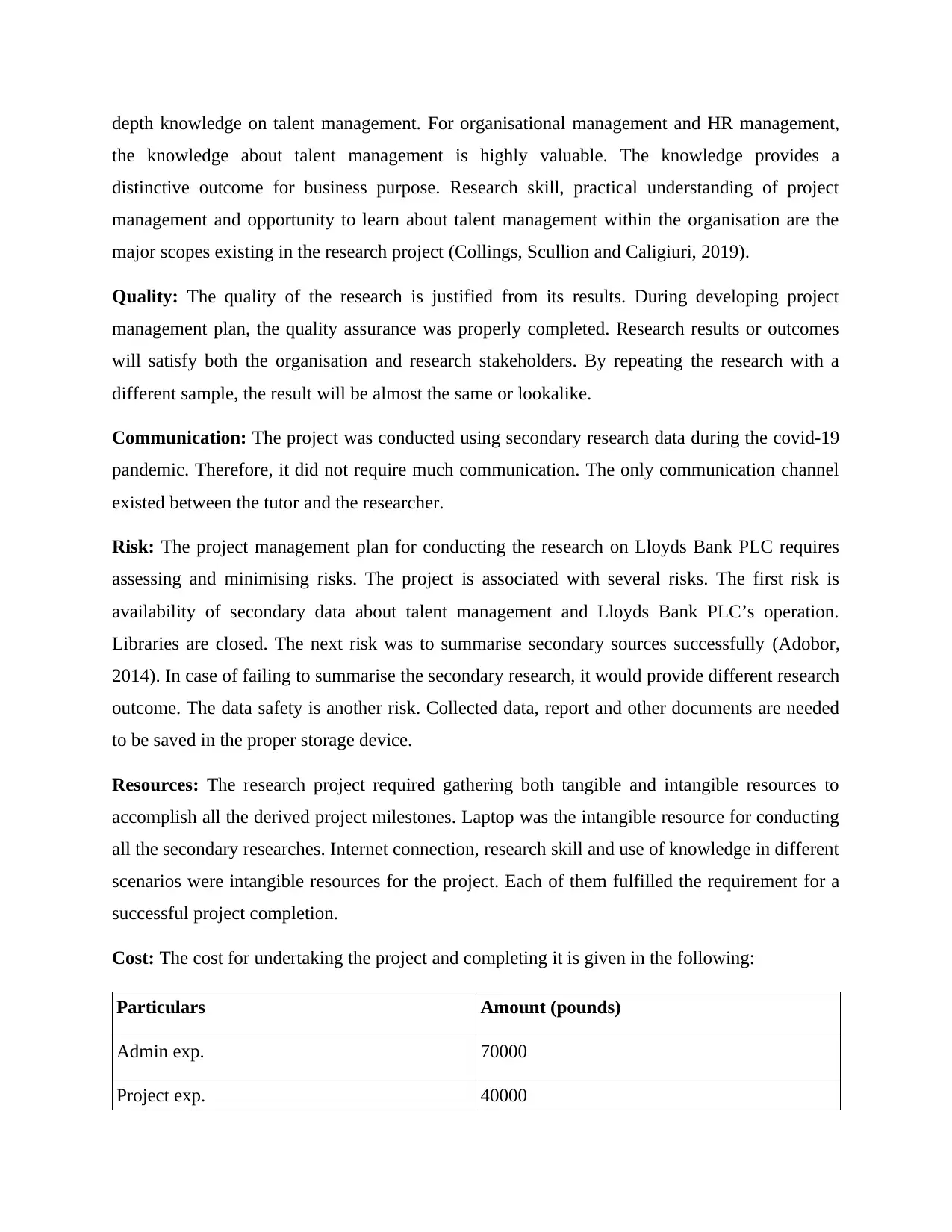
depth knowledge on talent management. For organisational management and HR management,
the knowledge about talent management is highly valuable. The knowledge provides a
distinctive outcome for business purpose. Research skill, practical understanding of project
management and opportunity to learn about talent management within the organisation are the
major scopes existing in the research project (Collings, Scullion and Caligiuri, 2019).
Quality: The quality of the research is justified from its results. During developing project
management plan, the quality assurance was properly completed. Research results or outcomes
will satisfy both the organisation and research stakeholders. By repeating the research with a
different sample, the result will be almost the same or lookalike.
Communication: The project was conducted using secondary research data during the covid-19
pandemic. Therefore, it did not require much communication. The only communication channel
existed between the tutor and the researcher.
Risk: The project management plan for conducting the research on Lloyds Bank PLC requires
assessing and minimising risks. The project is associated with several risks. The first risk is
availability of secondary data about talent management and Lloyds Bank PLC’s operation.
Libraries are closed. The next risk was to summarise secondary sources successfully (Adobor,
2014). In case of failing to summarise the secondary research, it would provide different research
outcome. The data safety is another risk. Collected data, report and other documents are needed
to be saved in the proper storage device.
Resources: The research project required gathering both tangible and intangible resources to
accomplish all the derived project milestones. Laptop was the intangible resource for conducting
all the secondary researches. Internet connection, research skill and use of knowledge in different
scenarios were intangible resources for the project. Each of them fulfilled the requirement for a
successful project completion.
Cost: The cost for undertaking the project and completing it is given in the following:
Particulars Amount (pounds)
Admin exp. 70000
Project exp. 40000
the knowledge about talent management is highly valuable. The knowledge provides a
distinctive outcome for business purpose. Research skill, practical understanding of project
management and opportunity to learn about talent management within the organisation are the
major scopes existing in the research project (Collings, Scullion and Caligiuri, 2019).
Quality: The quality of the research is justified from its results. During developing project
management plan, the quality assurance was properly completed. Research results or outcomes
will satisfy both the organisation and research stakeholders. By repeating the research with a
different sample, the result will be almost the same or lookalike.
Communication: The project was conducted using secondary research data during the covid-19
pandemic. Therefore, it did not require much communication. The only communication channel
existed between the tutor and the researcher.
Risk: The project management plan for conducting the research on Lloyds Bank PLC requires
assessing and minimising risks. The project is associated with several risks. The first risk is
availability of secondary data about talent management and Lloyds Bank PLC’s operation.
Libraries are closed. The next risk was to summarise secondary sources successfully (Adobor,
2014). In case of failing to summarise the secondary research, it would provide different research
outcome. The data safety is another risk. Collected data, report and other documents are needed
to be saved in the proper storage device.
Resources: The research project required gathering both tangible and intangible resources to
accomplish all the derived project milestones. Laptop was the intangible resource for conducting
all the secondary researches. Internet connection, research skill and use of knowledge in different
scenarios were intangible resources for the project. Each of them fulfilled the requirement for a
successful project completion.
Cost: The cost for undertaking the project and completing it is given in the following:
Particulars Amount (pounds)
Admin exp. 70000
Project exp. 40000
⊘ This is a preview!⊘
Do you want full access?
Subscribe today to unlock all pages.

Trusted by 1+ million students worldwide
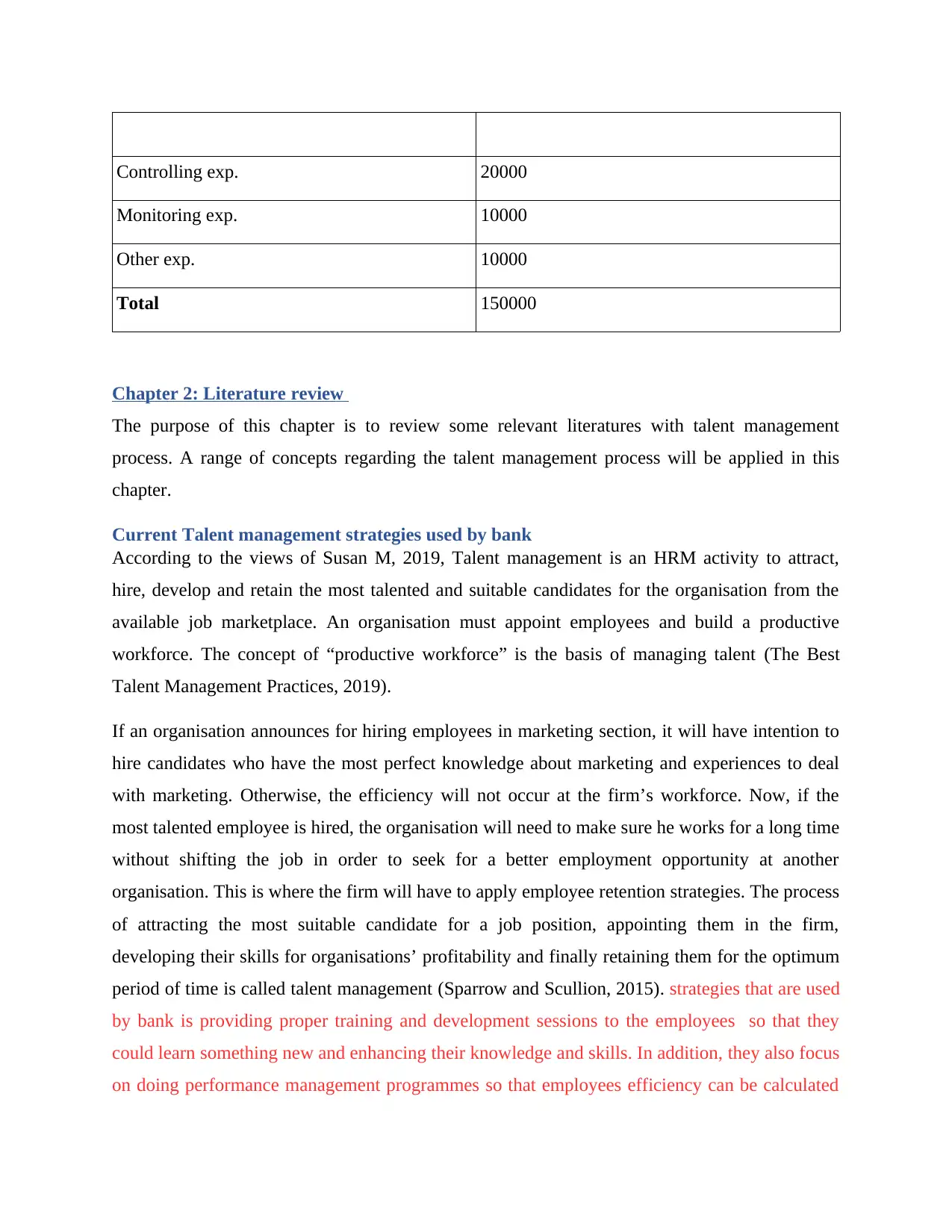
Controlling exp. 20000
Monitoring exp. 10000
Other exp. 10000
Total 150000
Chapter 2: Literature review
The purpose of this chapter is to review some relevant literatures with talent management
process. A range of concepts regarding the talent management process will be applied in this
chapter.
Current Talent management strategies used by bank
According to the views of Susan M, 2019, Talent management is an HRM activity to attract,
hire, develop and retain the most talented and suitable candidates for the organisation from the
available job marketplace. An organisation must appoint employees and build a productive
workforce. The concept of “productive workforce” is the basis of managing talent (The Best
Talent Management Practices, 2019).
If an organisation announces for hiring employees in marketing section, it will have intention to
hire candidates who have the most perfect knowledge about marketing and experiences to deal
with marketing. Otherwise, the efficiency will not occur at the firm’s workforce. Now, if the
most talented employee is hired, the organisation will need to make sure he works for a long time
without shifting the job in order to seek for a better employment opportunity at another
organisation. This is where the firm will have to apply employee retention strategies. The process
of attracting the most suitable candidate for a job position, appointing them in the firm,
developing their skills for organisations’ profitability and finally retaining them for the optimum
period of time is called talent management (Sparrow and Scullion, 2015). strategies that are used
by bank is providing proper training and development sessions to the employees so that they
could learn something new and enhancing their knowledge and skills. In addition, they also focus
on doing performance management programmes so that employees efficiency can be calculated
Monitoring exp. 10000
Other exp. 10000
Total 150000
Chapter 2: Literature review
The purpose of this chapter is to review some relevant literatures with talent management
process. A range of concepts regarding the talent management process will be applied in this
chapter.
Current Talent management strategies used by bank
According to the views of Susan M, 2019, Talent management is an HRM activity to attract,
hire, develop and retain the most talented and suitable candidates for the organisation from the
available job marketplace. An organisation must appoint employees and build a productive
workforce. The concept of “productive workforce” is the basis of managing talent (The Best
Talent Management Practices, 2019).
If an organisation announces for hiring employees in marketing section, it will have intention to
hire candidates who have the most perfect knowledge about marketing and experiences to deal
with marketing. Otherwise, the efficiency will not occur at the firm’s workforce. Now, if the
most talented employee is hired, the organisation will need to make sure he works for a long time
without shifting the job in order to seek for a better employment opportunity at another
organisation. This is where the firm will have to apply employee retention strategies. The process
of attracting the most suitable candidate for a job position, appointing them in the firm,
developing their skills for organisations’ profitability and finally retaining them for the optimum
period of time is called talent management (Sparrow and Scullion, 2015). strategies that are used
by bank is providing proper training and development sessions to the employees so that they
could learn something new and enhancing their knowledge and skills. In addition, they also focus
on doing performance management programmes so that employees efficiency can be calculated
Paraphrase This Document
Need a fresh take? Get an instant paraphrase of this document with our AI Paraphraser
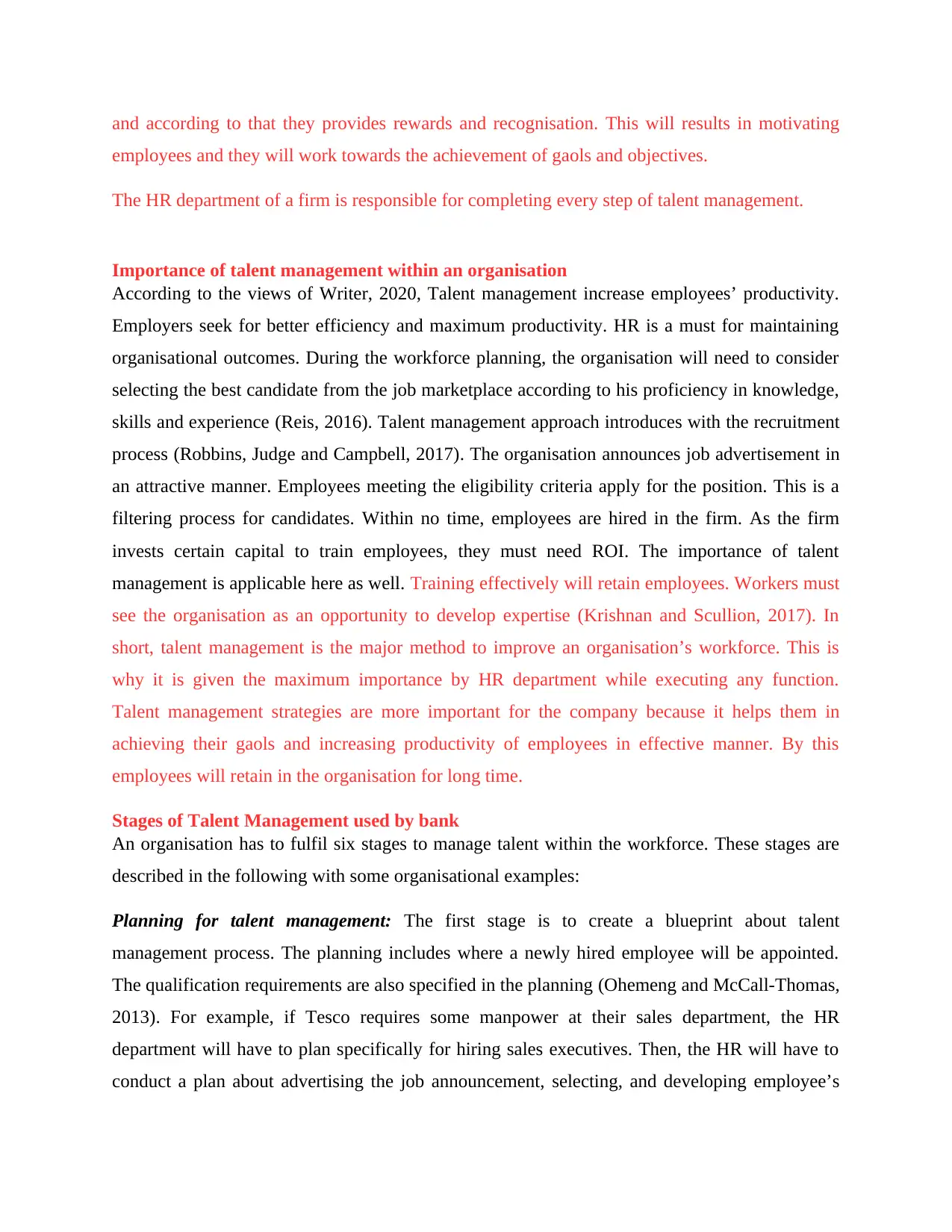
and according to that they provides rewards and recognisation. This will results in motivating
employees and they will work towards the achievement of gaols and objectives.
The HR department of a firm is responsible for completing every step of talent management.
Importance of talent management within an organisation
According to the views of Writer, 2020, Talent management increase employees’ productivity.
Employers seek for better efficiency and maximum productivity. HR is a must for maintaining
organisational outcomes. During the workforce planning, the organisation will need to consider
selecting the best candidate from the job marketplace according to his proficiency in knowledge,
skills and experience (Reis, 2016). Talent management approach introduces with the recruitment
process (Robbins, Judge and Campbell, 2017). The organisation announces job advertisement in
an attractive manner. Employees meeting the eligibility criteria apply for the position. This is a
filtering process for candidates. Within no time, employees are hired in the firm. As the firm
invests certain capital to train employees, they must need ROI. The importance of talent
management is applicable here as well. Training effectively will retain employees. Workers must
see the organisation as an opportunity to develop expertise (Krishnan and Scullion, 2017). In
short, talent management is the major method to improve an organisation’s workforce. This is
why it is given the maximum importance by HR department while executing any function.
Talent management strategies are more important for the company because it helps them in
achieving their gaols and increasing productivity of employees in effective manner. By this
employees will retain in the organisation for long time.
Stages of Talent Management used by bank
An organisation has to fulfil six stages to manage talent within the workforce. These stages are
described in the following with some organisational examples:
Planning for talent management: The first stage is to create a blueprint about talent
management process. The planning includes where a newly hired employee will be appointed.
The qualification requirements are also specified in the planning (Ohemeng and McCall-Thomas,
2013). For example, if Tesco requires some manpower at their sales department, the HR
department will have to plan specifically for hiring sales executives. Then, the HR will have to
conduct a plan about advertising the job announcement, selecting, and developing employee’s
employees and they will work towards the achievement of gaols and objectives.
The HR department of a firm is responsible for completing every step of talent management.
Importance of talent management within an organisation
According to the views of Writer, 2020, Talent management increase employees’ productivity.
Employers seek for better efficiency and maximum productivity. HR is a must for maintaining
organisational outcomes. During the workforce planning, the organisation will need to consider
selecting the best candidate from the job marketplace according to his proficiency in knowledge,
skills and experience (Reis, 2016). Talent management approach introduces with the recruitment
process (Robbins, Judge and Campbell, 2017). The organisation announces job advertisement in
an attractive manner. Employees meeting the eligibility criteria apply for the position. This is a
filtering process for candidates. Within no time, employees are hired in the firm. As the firm
invests certain capital to train employees, they must need ROI. The importance of talent
management is applicable here as well. Training effectively will retain employees. Workers must
see the organisation as an opportunity to develop expertise (Krishnan and Scullion, 2017). In
short, talent management is the major method to improve an organisation’s workforce. This is
why it is given the maximum importance by HR department while executing any function.
Talent management strategies are more important for the company because it helps them in
achieving their gaols and increasing productivity of employees in effective manner. By this
employees will retain in the organisation for long time.
Stages of Talent Management used by bank
An organisation has to fulfil six stages to manage talent within the workforce. These stages are
described in the following with some organisational examples:
Planning for talent management: The first stage is to create a blueprint about talent
management process. The planning includes where a newly hired employee will be appointed.
The qualification requirements are also specified in the planning (Ohemeng and McCall-Thomas,
2013). For example, if Tesco requires some manpower at their sales department, the HR
department will have to plan specifically for hiring sales executives. Then, the HR will have to
conduct a plan about advertising the job announcement, selecting, and developing employee’s
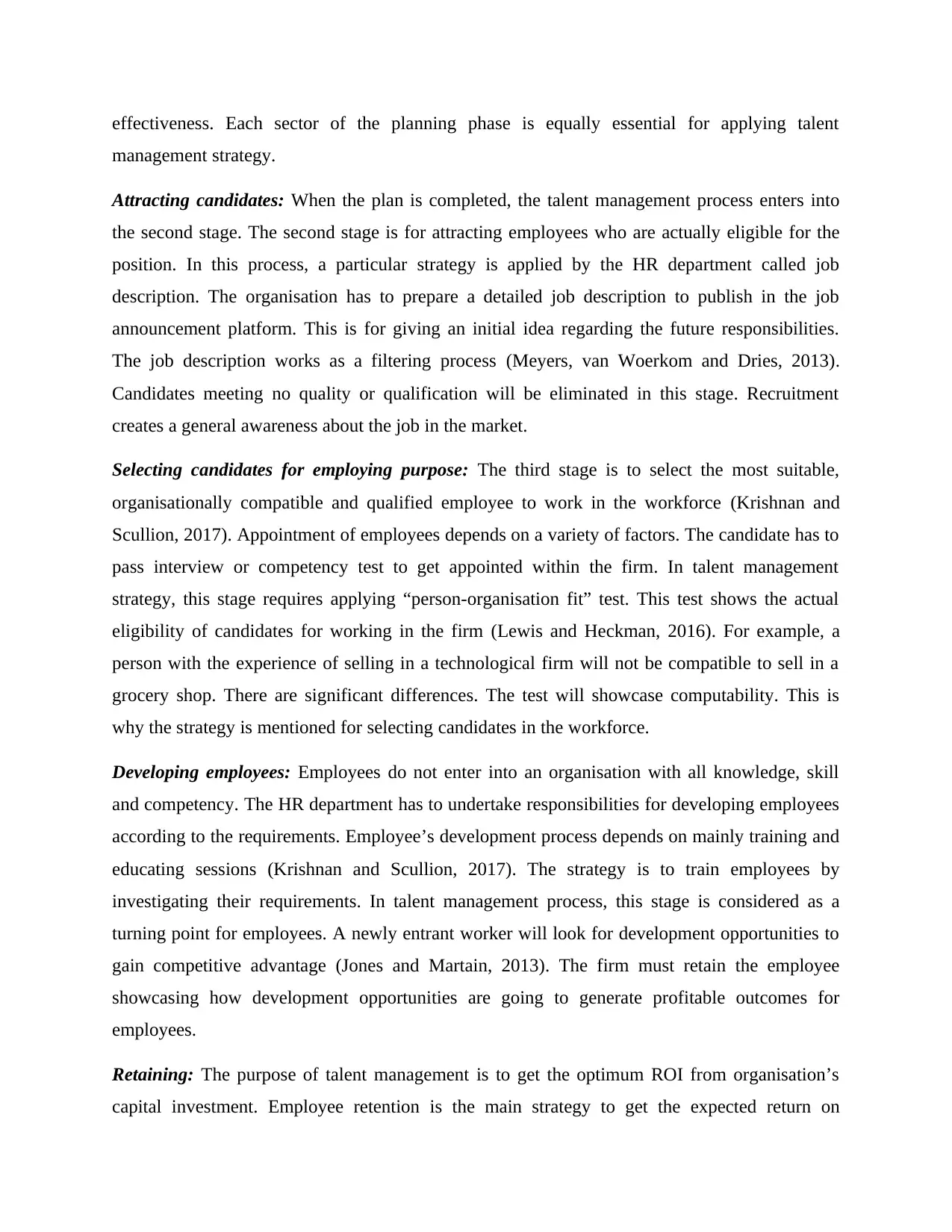
effectiveness. Each sector of the planning phase is equally essential for applying talent
management strategy.
Attracting candidates: When the plan is completed, the talent management process enters into
the second stage. The second stage is for attracting employees who are actually eligible for the
position. In this process, a particular strategy is applied by the HR department called job
description. The organisation has to prepare a detailed job description to publish in the job
announcement platform. This is for giving an initial idea regarding the future responsibilities.
The job description works as a filtering process (Meyers, van Woerkom and Dries, 2013).
Candidates meeting no quality or qualification will be eliminated in this stage. Recruitment
creates a general awareness about the job in the market.
Selecting candidates for employing purpose: The third stage is to select the most suitable,
organisationally compatible and qualified employee to work in the workforce (Krishnan and
Scullion, 2017). Appointment of employees depends on a variety of factors. The candidate has to
pass interview or competency test to get appointed within the firm. In talent management
strategy, this stage requires applying “person-organisation fit” test. This test shows the actual
eligibility of candidates for working in the firm (Lewis and Heckman, 2016). For example, a
person with the experience of selling in a technological firm will not be compatible to sell in a
grocery shop. There are significant differences. The test will showcase computability. This is
why the strategy is mentioned for selecting candidates in the workforce.
Developing employees: Employees do not enter into an organisation with all knowledge, skill
and competency. The HR department has to undertake responsibilities for developing employees
according to the requirements. Employee’s development process depends on mainly training and
educating sessions (Krishnan and Scullion, 2017). The strategy is to train employees by
investigating their requirements. In talent management process, this stage is considered as a
turning point for employees. A newly entrant worker will look for development opportunities to
gain competitive advantage (Jones and Martain, 2013). The firm must retain the employee
showcasing how development opportunities are going to generate profitable outcomes for
employees.
Retaining: The purpose of talent management is to get the optimum ROI from organisation’s
capital investment. Employee retention is the main strategy to get the expected return on
management strategy.
Attracting candidates: When the plan is completed, the talent management process enters into
the second stage. The second stage is for attracting employees who are actually eligible for the
position. In this process, a particular strategy is applied by the HR department called job
description. The organisation has to prepare a detailed job description to publish in the job
announcement platform. This is for giving an initial idea regarding the future responsibilities.
The job description works as a filtering process (Meyers, van Woerkom and Dries, 2013).
Candidates meeting no quality or qualification will be eliminated in this stage. Recruitment
creates a general awareness about the job in the market.
Selecting candidates for employing purpose: The third stage is to select the most suitable,
organisationally compatible and qualified employee to work in the workforce (Krishnan and
Scullion, 2017). Appointment of employees depends on a variety of factors. The candidate has to
pass interview or competency test to get appointed within the firm. In talent management
strategy, this stage requires applying “person-organisation fit” test. This test shows the actual
eligibility of candidates for working in the firm (Lewis and Heckman, 2016). For example, a
person with the experience of selling in a technological firm will not be compatible to sell in a
grocery shop. There are significant differences. The test will showcase computability. This is
why the strategy is mentioned for selecting candidates in the workforce.
Developing employees: Employees do not enter into an organisation with all knowledge, skill
and competency. The HR department has to undertake responsibilities for developing employees
according to the requirements. Employee’s development process depends on mainly training and
educating sessions (Krishnan and Scullion, 2017). The strategy is to train employees by
investigating their requirements. In talent management process, this stage is considered as a
turning point for employees. A newly entrant worker will look for development opportunities to
gain competitive advantage (Jones and Martain, 2013). The firm must retain the employee
showcasing how development opportunities are going to generate profitable outcomes for
employees.
Retaining: The purpose of talent management is to get the optimum ROI from organisation’s
capital investment. Employee retention is the main strategy to get the expected return on
⊘ This is a preview!⊘
Do you want full access?
Subscribe today to unlock all pages.

Trusted by 1+ million students worldwide
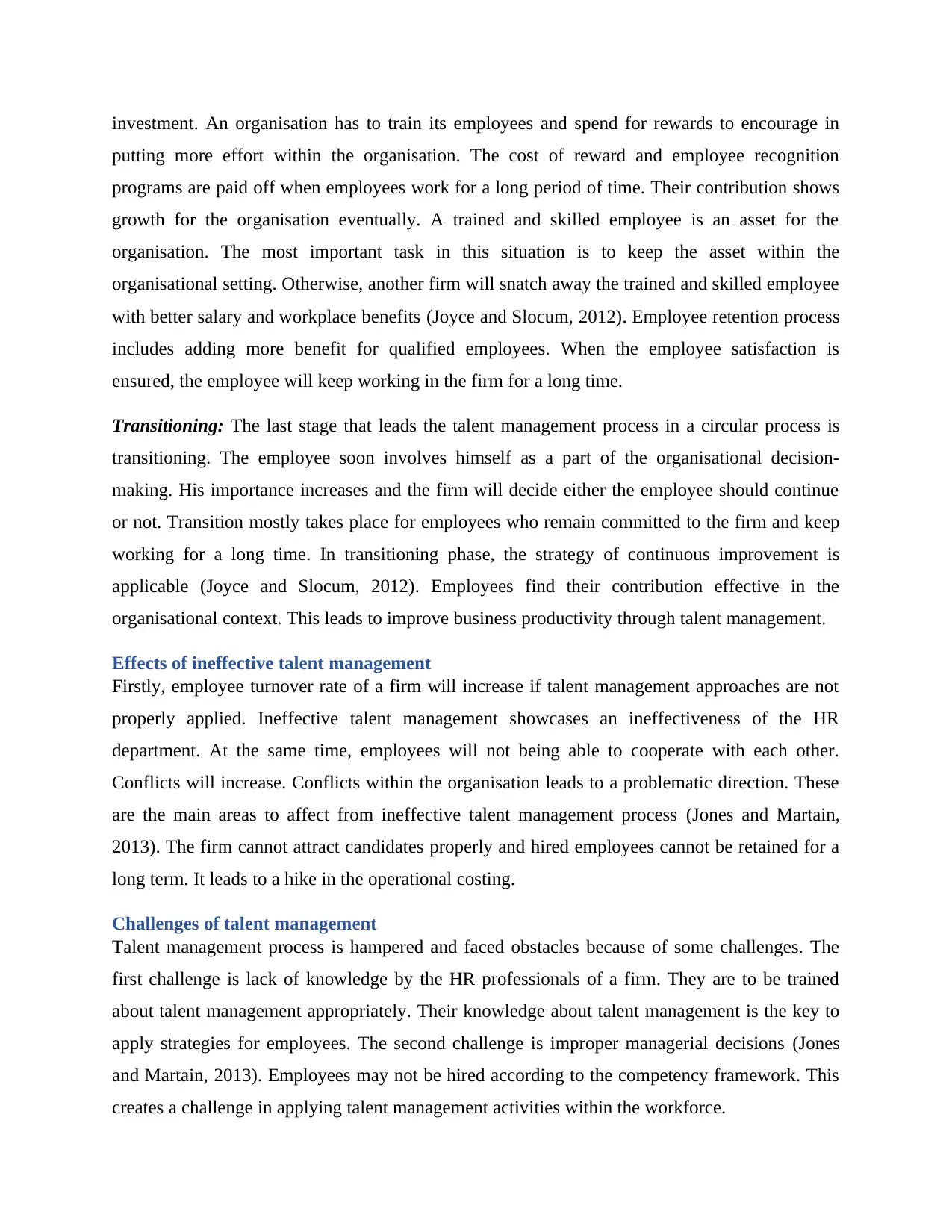
investment. An organisation has to train its employees and spend for rewards to encourage in
putting more effort within the organisation. The cost of reward and employee recognition
programs are paid off when employees work for a long period of time. Their contribution shows
growth for the organisation eventually. A trained and skilled employee is an asset for the
organisation. The most important task in this situation is to keep the asset within the
organisational setting. Otherwise, another firm will snatch away the trained and skilled employee
with better salary and workplace benefits (Joyce and Slocum, 2012). Employee retention process
includes adding more benefit for qualified employees. When the employee satisfaction is
ensured, the employee will keep working in the firm for a long time.
Transitioning: The last stage that leads the talent management process in a circular process is
transitioning. The employee soon involves himself as a part of the organisational decision-
making. His importance increases and the firm will decide either the employee should continue
or not. Transition mostly takes place for employees who remain committed to the firm and keep
working for a long time. In transitioning phase, the strategy of continuous improvement is
applicable (Joyce and Slocum, 2012). Employees find their contribution effective in the
organisational context. This leads to improve business productivity through talent management.
Effects of ineffective talent management
Firstly, employee turnover rate of a firm will increase if talent management approaches are not
properly applied. Ineffective talent management showcases an ineffectiveness of the HR
department. At the same time, employees will not being able to cooperate with each other.
Conflicts will increase. Conflicts within the organisation leads to a problematic direction. These
are the main areas to affect from ineffective talent management process (Jones and Martain,
2013). The firm cannot attract candidates properly and hired employees cannot be retained for a
long term. It leads to a hike in the operational costing.
Challenges of talent management
Talent management process is hampered and faced obstacles because of some challenges. The
first challenge is lack of knowledge by the HR professionals of a firm. They are to be trained
about talent management appropriately. Their knowledge about talent management is the key to
apply strategies for employees. The second challenge is improper managerial decisions (Jones
and Martain, 2013). Employees may not be hired according to the competency framework. This
creates a challenge in applying talent management activities within the workforce.
putting more effort within the organisation. The cost of reward and employee recognition
programs are paid off when employees work for a long period of time. Their contribution shows
growth for the organisation eventually. A trained and skilled employee is an asset for the
organisation. The most important task in this situation is to keep the asset within the
organisational setting. Otherwise, another firm will snatch away the trained and skilled employee
with better salary and workplace benefits (Joyce and Slocum, 2012). Employee retention process
includes adding more benefit for qualified employees. When the employee satisfaction is
ensured, the employee will keep working in the firm for a long time.
Transitioning: The last stage that leads the talent management process in a circular process is
transitioning. The employee soon involves himself as a part of the organisational decision-
making. His importance increases and the firm will decide either the employee should continue
or not. Transition mostly takes place for employees who remain committed to the firm and keep
working for a long time. In transitioning phase, the strategy of continuous improvement is
applicable (Joyce and Slocum, 2012). Employees find their contribution effective in the
organisational context. This leads to improve business productivity through talent management.
Effects of ineffective talent management
Firstly, employee turnover rate of a firm will increase if talent management approaches are not
properly applied. Ineffective talent management showcases an ineffectiveness of the HR
department. At the same time, employees will not being able to cooperate with each other.
Conflicts will increase. Conflicts within the organisation leads to a problematic direction. These
are the main areas to affect from ineffective talent management process (Jones and Martain,
2013). The firm cannot attract candidates properly and hired employees cannot be retained for a
long term. It leads to a hike in the operational costing.
Challenges of talent management
Talent management process is hampered and faced obstacles because of some challenges. The
first challenge is lack of knowledge by the HR professionals of a firm. They are to be trained
about talent management appropriately. Their knowledge about talent management is the key to
apply strategies for employees. The second challenge is improper managerial decisions (Jones
and Martain, 2013). Employees may not be hired according to the competency framework. This
creates a challenge in applying talent management activities within the workforce.
Paraphrase This Document
Need a fresh take? Get an instant paraphrase of this document with our AI Paraphraser
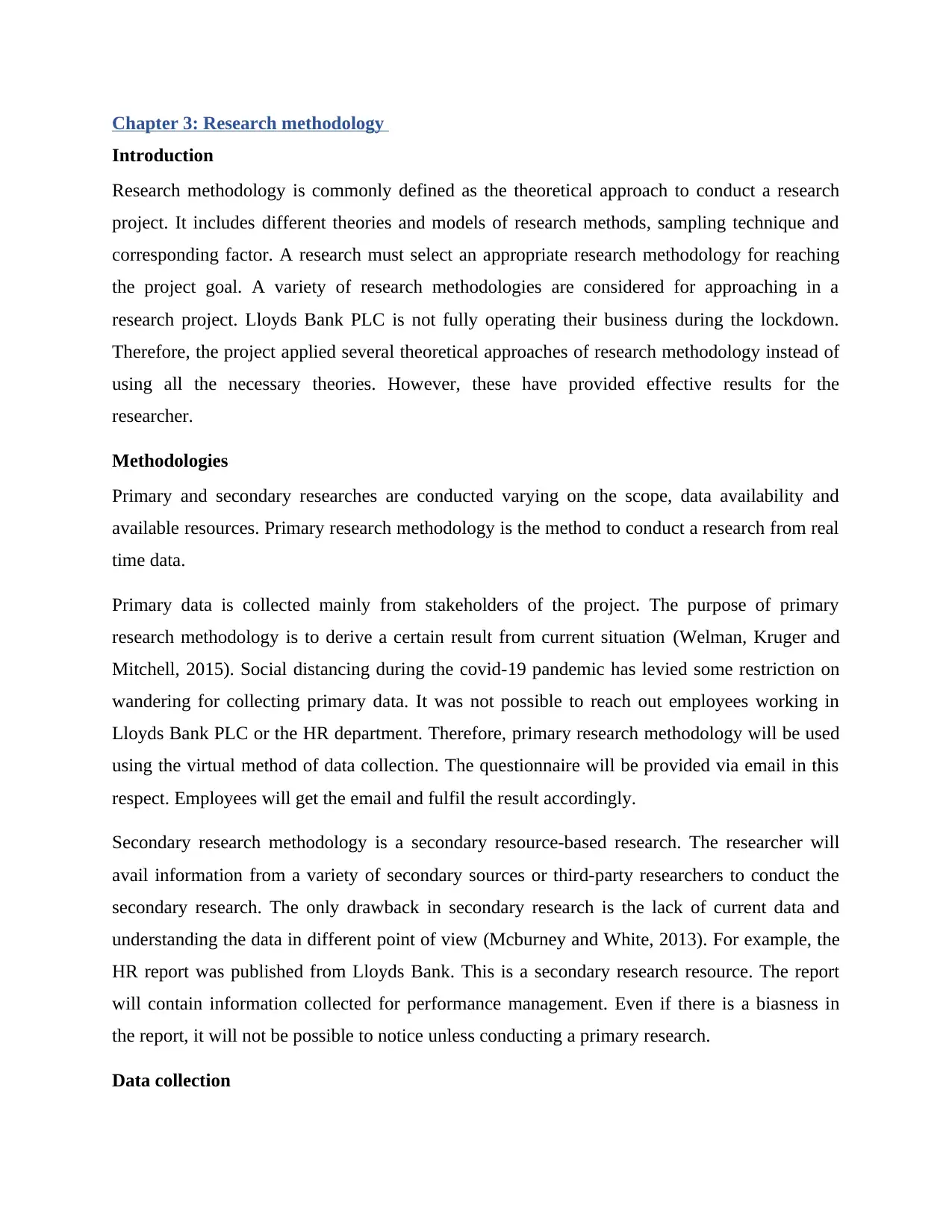
Chapter 3: Research methodology
Introduction
Research methodology is commonly defined as the theoretical approach to conduct a research
project. It includes different theories and models of research methods, sampling technique and
corresponding factor. A research must select an appropriate research methodology for reaching
the project goal. A variety of research methodologies are considered for approaching in a
research project. Lloyds Bank PLC is not fully operating their business during the lockdown.
Therefore, the project applied several theoretical approaches of research methodology instead of
using all the necessary theories. However, these have provided effective results for the
researcher.
Methodologies
Primary and secondary researches are conducted varying on the scope, data availability and
available resources. Primary research methodology is the method to conduct a research from real
time data.
Primary data is collected mainly from stakeholders of the project. The purpose of primary
research methodology is to derive a certain result from current situation (Welman, Kruger and
Mitchell, 2015). Social distancing during the covid-19 pandemic has levied some restriction on
wandering for collecting primary data. It was not possible to reach out employees working in
Lloyds Bank PLC or the HR department. Therefore, primary research methodology will be used
using the virtual method of data collection. The questionnaire will be provided via email in this
respect. Employees will get the email and fulfil the result accordingly.
Secondary research methodology is a secondary resource-based research. The researcher will
avail information from a variety of secondary sources or third-party researchers to conduct the
secondary research. The only drawback in secondary research is the lack of current data and
understanding the data in different point of view (Mcburney and White, 2013). For example, the
HR report was published from Lloyds Bank. This is a secondary research resource. The report
will contain information collected for performance management. Even if there is a biasness in
the report, it will not be possible to notice unless conducting a primary research.
Data collection
Introduction
Research methodology is commonly defined as the theoretical approach to conduct a research
project. It includes different theories and models of research methods, sampling technique and
corresponding factor. A research must select an appropriate research methodology for reaching
the project goal. A variety of research methodologies are considered for approaching in a
research project. Lloyds Bank PLC is not fully operating their business during the lockdown.
Therefore, the project applied several theoretical approaches of research methodology instead of
using all the necessary theories. However, these have provided effective results for the
researcher.
Methodologies
Primary and secondary researches are conducted varying on the scope, data availability and
available resources. Primary research methodology is the method to conduct a research from real
time data.
Primary data is collected mainly from stakeholders of the project. The purpose of primary
research methodology is to derive a certain result from current situation (Welman, Kruger and
Mitchell, 2015). Social distancing during the covid-19 pandemic has levied some restriction on
wandering for collecting primary data. It was not possible to reach out employees working in
Lloyds Bank PLC or the HR department. Therefore, primary research methodology will be used
using the virtual method of data collection. The questionnaire will be provided via email in this
respect. Employees will get the email and fulfil the result accordingly.
Secondary research methodology is a secondary resource-based research. The researcher will
avail information from a variety of secondary sources or third-party researchers to conduct the
secondary research. The only drawback in secondary research is the lack of current data and
understanding the data in different point of view (Mcburney and White, 2013). For example, the
HR report was published from Lloyds Bank. This is a secondary research resource. The report
will contain information collected for performance management. Even if there is a biasness in
the report, it will not be possible to notice unless conducting a primary research.
Data collection
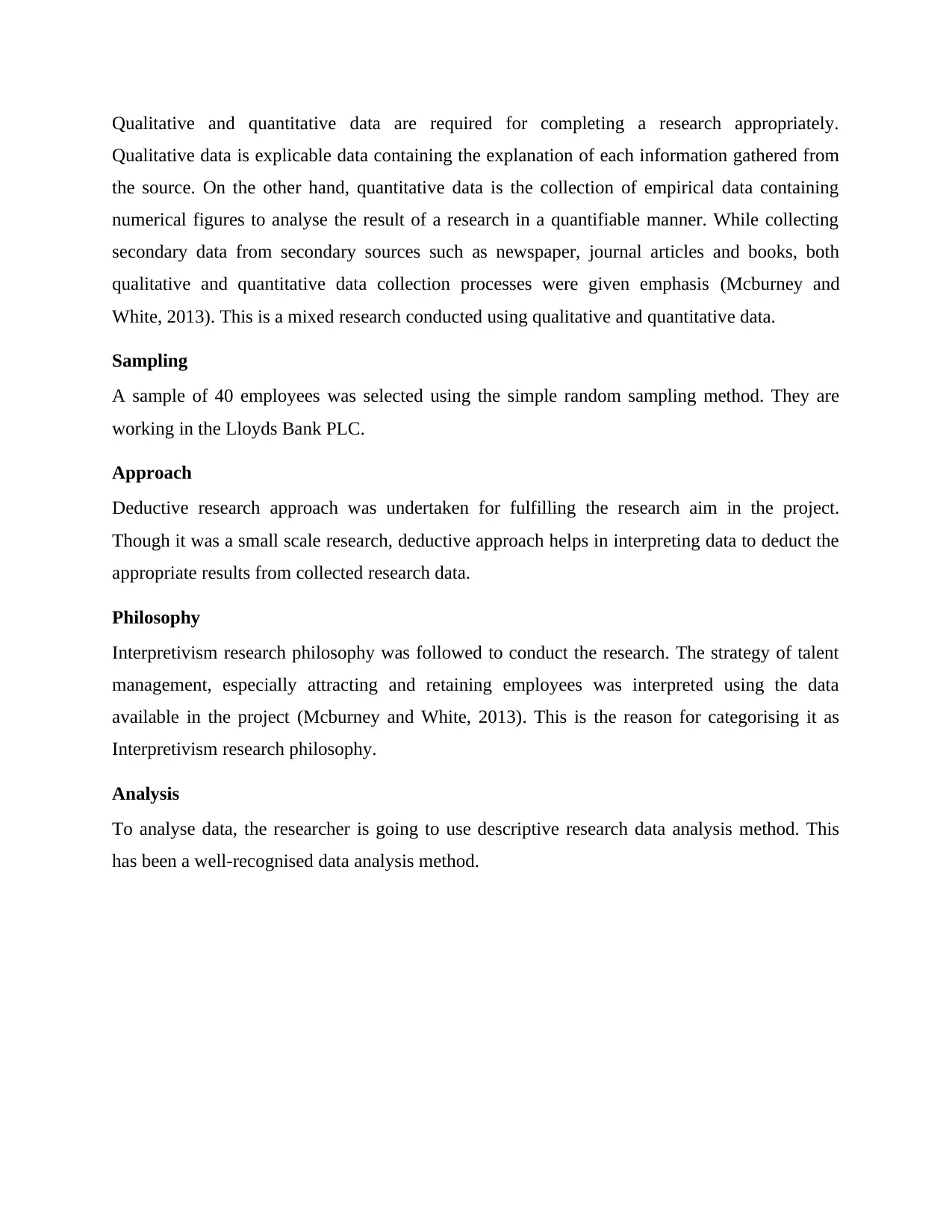
Qualitative and quantitative data are required for completing a research appropriately.
Qualitative data is explicable data containing the explanation of each information gathered from
the source. On the other hand, quantitative data is the collection of empirical data containing
numerical figures to analyse the result of a research in a quantifiable manner. While collecting
secondary data from secondary sources such as newspaper, journal articles and books, both
qualitative and quantitative data collection processes were given emphasis (Mcburney and
White, 2013). This is a mixed research conducted using qualitative and quantitative data.
Sampling
A sample of 40 employees was selected using the simple random sampling method. They are
working in the Lloyds Bank PLC.
Approach
Deductive research approach was undertaken for fulfilling the research aim in the project.
Though it was a small scale research, deductive approach helps in interpreting data to deduct the
appropriate results from collected research data.
Philosophy
Interpretivism research philosophy was followed to conduct the research. The strategy of talent
management, especially attracting and retaining employees was interpreted using the data
available in the project (Mcburney and White, 2013). This is the reason for categorising it as
Interpretivism research philosophy.
Analysis
To analyse data, the researcher is going to use descriptive research data analysis method. This
has been a well-recognised data analysis method.
Qualitative data is explicable data containing the explanation of each information gathered from
the source. On the other hand, quantitative data is the collection of empirical data containing
numerical figures to analyse the result of a research in a quantifiable manner. While collecting
secondary data from secondary sources such as newspaper, journal articles and books, both
qualitative and quantitative data collection processes were given emphasis (Mcburney and
White, 2013). This is a mixed research conducted using qualitative and quantitative data.
Sampling
A sample of 40 employees was selected using the simple random sampling method. They are
working in the Lloyds Bank PLC.
Approach
Deductive research approach was undertaken for fulfilling the research aim in the project.
Though it was a small scale research, deductive approach helps in interpreting data to deduct the
appropriate results from collected research data.
Philosophy
Interpretivism research philosophy was followed to conduct the research. The strategy of talent
management, especially attracting and retaining employees was interpreted using the data
available in the project (Mcburney and White, 2013). This is the reason for categorising it as
Interpretivism research philosophy.
Analysis
To analyse data, the researcher is going to use descriptive research data analysis method. This
has been a well-recognised data analysis method.
⊘ This is a preview!⊘
Do you want full access?
Subscribe today to unlock all pages.

Trusted by 1+ million students worldwide
1 out of 33
Related Documents
Your All-in-One AI-Powered Toolkit for Academic Success.
+13062052269
info@desklib.com
Available 24*7 on WhatsApp / Email
![[object Object]](/_next/static/media/star-bottom.7253800d.svg)
Unlock your academic potential
Copyright © 2020–2025 A2Z Services. All Rights Reserved. Developed and managed by ZUCOL.




